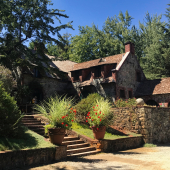Marshall Gold Discovery State Historic Park
Marshall Gold Discrovery State Park Main Entrance by UncleVinnie is licensed under CC by 3.0
It’s hard to believe that this pretty, secluded valley near Coloma is the epicenter of one of the most consequential events in American history, and one that has shaped California history for the past 174 years. In 1848, James W. Marshall discovered flakes of gold in the South Fork of the American River while building a saw mill for John Sutter. Word of the discovery quickly got out, triggering the Gold Rush of 1849. There are near-countless volumes of history texts written about the Gold Rush and its aftermath, but nothing beats actually visiting the place where it started.
The 576 acre Marshall Gold Discovery State Park encompasses the discovery site and the surrounding area, with several miles of trails for hiking and horseback riding. The museum features a number of interpretive exhibits telling the stories of the original inhabitants and those who came looking for gold.
Many of the original buildings are still in the park. A short loop trail outside of the museum takes you by several original and reconstructed buildings showcasing the lives of Native Americans and miners from all cultures that came to the area.
The newly opened Gam Saan trail connects to nearby Hennigsen Lotus park, and highlights the stories of Chinese forty-niners and miners who lived in Coloma. Walking tours are available through the park, or take the Monument Trail or Monroe Ridge trails for longer hikes.
You can still pan for gold in the river, and many people find flecks of gold and garnets that wash down. You are invited to bring your own pan, or you can buy one in Marshall Gold Mercantile. The park offers 15 minute lessons to help get you oriented and learn proper gold-panning technique. For more information, check out the Gold Discovery Park Association website.

